Your Handy 1966–85 Fiat 124 Spider Buyer’s Guide
Of all the years Fiat chose to launch its new Spider sports car, it had to pick 1966. If the Italian giant had gone either side of this with its pert roadster, it would surely have garnered far more coverage and, perhaps, would be more widely regarded in today’s classic world. Instead, the 124 Spider arrived headlong into the whirlwind surrounding the Alfa Romeo Spider that had broken cover at the Geneva motor show earlier in the year, while Fiat waited until the Turin show toward the end of 1966 for its big reveal.
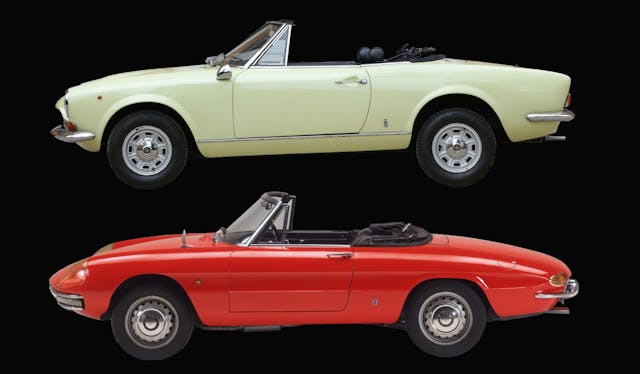
Both cars came from the Pininfarina studio, and while the Alfa was styled by Battista Pininfarina (the last car designed by him), the Fiat 124 Spider was the work of Dutch-American designer Tom Tjaarda. Undoubtedly pretty and the epitome of what a compact sporting roadster should be, the 124 was based on the same platform as the 124 coupe, but with a shortened wheelbase to keep the proportions spot on.
When you opened the hood, the twin-cam engine was nestled in there snug, and upon launch, the 1438-cc unit made 90 hp. It was initially mated to a torque tube transmission, but in 1969 that was dropped, as it was prone to cracking, and it was replaced by a standard propshaft. Also in 1969, the 1.4-liter engine was upgraded to a 1608-cc twin-cam making 110 hp. It was just as perky as its predecessor, but a small hood bulge was needed to clear its twin carburetors. More engine upgrades followed in 1972, when the 1592cc and 1756cc engines from Fiat’s 132 range were fitted to the Spider, creating a new 1800 model alongside the existing 1600 version.
Also in 1972 came the 124 Abarth Rallye, a homologation special to take the 124 Spider into European competition. It came with a 128-hp 1.8-liter twin-cam motor, coil-spring rear suspension, a roll cage, and lightweight body panels made from aluminum and fiberglass. In full rally-ready trim, the Abarth Rallye could be ordered with as much as 170 hp from the factory, but only 1013 were made to qualify it for competition, and it was regarded as too loud and coarse as a road car. Very few exist in the U.S.

In the 124 Spider’s second decade, a second chapter began. European and other markets were cut off as Fiat concentrated on the U.S., where the car had always enjoyed its best sales. However, American-spec Spiders came with a measly 86 hp from their 1.8-liter engines, and federal crash regulations necessitated a slightly lifted ride height and larger bumpers mid-decade. For 1979, the car was fitted with a carbuereted 2.0-liter engine, still making 86 hp, and was rebadged as the Fiat Spider 2000. Fuel injection was introduced midway through 1980, which upped output to 102 hp.
Fiat also offered a turbocharged version of the 124 Spider in 1981. The conversions were carried out by Legend Industries in New York and it is estimated that about 700 were built, complete with Cromodora alloy wheels and unique badging. The turbo increased power to 125 hp. Meanwhile, European customers could once again order the 124, then called the Spider Europa, with a 105-hp 2.0-liter engine.
In European markets, there was one last throw of the dice for the aging Fiat when the carmaker offered a supercharged version of the 2.0, which bumped output to 135 hp. Only about 500 were built. Fiat had already exited the U.S. market by 1983, but the cars soldiered on under the Pininfarina Azzurra badge. The two-seater finally ended production in 1985, two decades after it debuted. All were made with left-hand drive, but several were converted to right-hand drive for the U.K. market using 124 coupe parts.
What’s a 124 Spider Like to Drive?
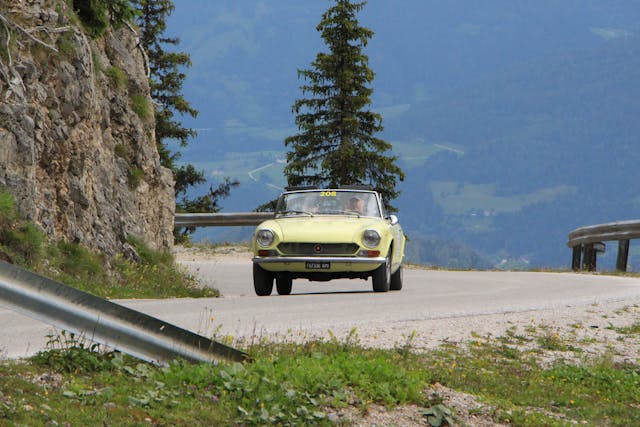
When it came to two-seat affordable roadsters in the mid-1960s, buyers were spoiled for choice. At first glance, given the 124’s specs, Fiat didn’t do much to make the Spider stand out from that crowd. However, the 90-hp 1.4-liter engine thrives on revs, so you have to work it quite hard. Driven this way, it sounds good thanks to the induction noise from the carb and the exhaust note, and it has a bit more bass and growl than you’d expect from a small-capacity four-cylinder.
The five-speed manual gearbox has a pleasingly accurate feel, and the ratios are spread evenly to make the most of the engine’s power. Off the mark, an early Spider could cover 0–60mph in 10.9 seconds and top out at 109 mph, but more relevant today is that you can easily keep up with modern traffic. This makes the Fiat a very usable classic, regardless of which engine you choose, though the 1.8s of the late ’70s are fairly gutless.
Whichever engine you prefer, the rear-drive setup of the 124 Spider makes it enjoyable to sift through a series of corners to find the limits of the car. Turn-in is good and there’s plenty of mid-corner grip and steering feel. You’re unlikely to experience any oversteer, unless the tires are worn or the road is greasy, so the 124 Spider is a car anyone can drive with confidence, especially as it is aided by disc brakes all-around. It’s also decent at flowing with the road over bumps and, at the risk of upsetting MG drivers, is smoother and more refined than a B roadster.
With the top up in a car that has been looked after, you shouldn’t find any rain getting in past the seals. There is a fair degree of wind noise, which is true of any of the 124’s rivals, but the top is quick and easy to operate. You also get a decent trunk, and there’s more storage behind the seats on a bench that is optimistically trimmed as if it might accommodate children. It won’t. The rest of the Spider’s cabin is simple and easy to live with, though you will have to remember the heater controls are quirkily placed down by the handbrake lever.
Valuation

Any Fiat 124 Spider in running order but in need of work to the mechanics and cosmetics (#4 “Fair” condition) will cost around $6000. As with most classic cars, it’s wiser to look at increasing your budget to buy one in better condition than it is to spend far more sorting a rough car. A 124 Spider in decent order that you can use and enjoy, without worrying about it going out in the rain (#3 “Good”), will cost around $13,000 for a 2.0-liter model, and around the same for a 1.6- or 1.8-liter car. Meanwhile, a fully sorted, concours-quality 1.4 will eclipse $30,000.
What to Look for in a 124?

There are no particular weak spots with the Fiat 124 Spider, beyond the usual problems any classic roadster from this period can experience. Namely, rust. Cars from dry states have the advantage here, but that’s no guarantee it will be rot-free, and they can also pose other potential problems such as faded paint and cracked trim.

With any 124 Spider, the areas to look for rot present like the greatest hits of classic car rust traps. This means inspecting the wheel arches, fender edges, sills, floorpans, chassis legs, front suspension crossmember, trunk lid, and inner fenders with a wary eye. Stand back and have a good look at the panel gap around the doors. If they have closed up at any point, especially toward the top of the doors, it’s a good indicator the car’s shell is seriously weakened by rust.
The suspension, steering, and brakes are all simple to work on and parts are available, with many shared by other Fiat models of the period. The engine and gearbox are more bespoke to the 124 Spider, and there was an automatic transmission offered after 1979. Unless you really want this, we’d stick with the manuals, where you just need to make sure it doesn’t pop out of gear under acceleration or make any rumbling noises.
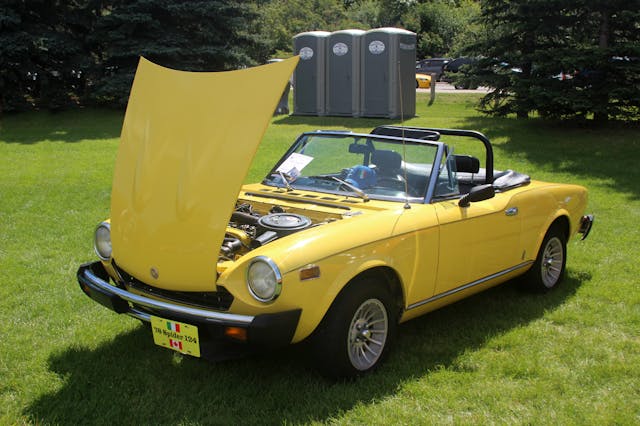
Fiat 124 Spider engines tend to leak a little oil as a habit, so don’t fret over a light misting, but do check for more serious drips underneath the car. The oil sump sits low to the ground in the 124 and gets knocked about, which can lead to oil loss. Back on top of the engine, give the cooling system a thorough going over for leaks and splits in hoses, and look to see of the head gasket has leaked due to low coolant level.
Most electrical issues will be caused by a poor ground or elderly components, but a common complaint among 124 Spider owners is dim headlights with the original setup. This can be improved with modern bulbs or even an LED conversion. Rear lights for the early 1.4-liter cars are now hard to find, so be sure they are not damaged.
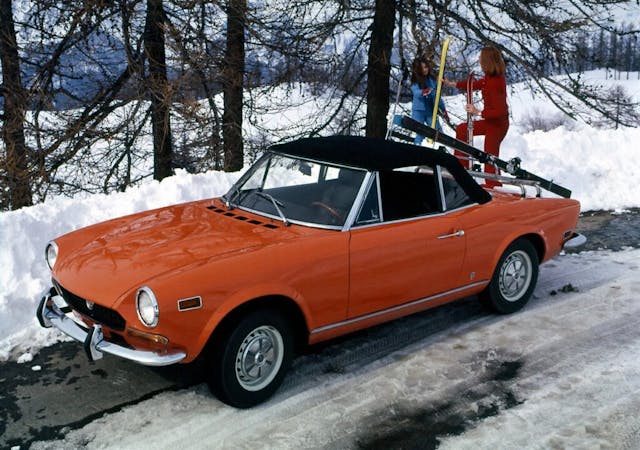
A visual inspection of the 124 Spider’s top should quickly tell you if it needs to be repaired or replaced. A new one in vinyl is around $500 and is a relatively simple DIY job to fit. With the rest of the 124 Spider’s interior, make sure all of the buttons, dials, badges, and switches are present, as they can be hard to track down, and there are differences between the years that purists will be keen to get right.
Which Is the Right 124 Spider for You?

Fiat built nearly 200,000 copies of the 124 Spider, and one in rude health is a car that will quickly win you over with its crisp engine response and exhaust note, its sharp steering, and its deft handling. The 124 is quick enough to keep pace with modern traffic and also sufficiently comfortable to put up with daily use. If anything, it’s a car that thrives on regular exercise to ward off niggling problems.
The only engine we’d avoid is the 87-hp 1.8-liter lump from 1977–79, as you can have a much perkier 1.6- or 2.0-liter Spider for the same money. To enjoy the 124 Spider in its original form, the 90-hp 1.4 is a real joy to drive and use, but for most potential buyers we reckon the 110-hp 1.6 of the early ’70s is the pick of the bunch, not only because there are plenty around, but because its performance and usability are perfectly in keeping with the Fiat’s zesty nature.

***
Check out the Hagerty Media homepage so you don’t miss a single story, or better yet, bookmark it. To get our best stories delivered right to your inbox, subscribe to our newsletters.
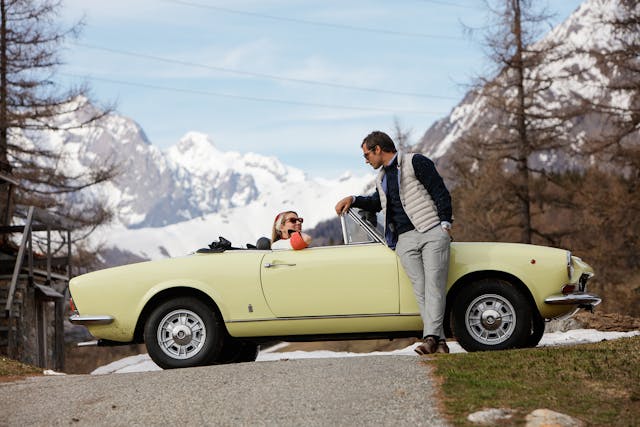


Auto Ricambi is a great source for replacement parts for the FIAT Spider.
Very informative article!
As a former FIAT Spider owner, my buying guide is — don’t.
I had a 1980 Spider 2000 and thoroughly enjoyed it. But it was only a few years old. Today it would be nearly 45, and I seriously doubt it would have suffered those years well. These were not tough cars built to last a lifetime. I think I’d second audiobycarmine’s comment unless you can either find that ONE example that’s been hermetically sealed for 40 years, or if you have a time machine and go drive one before it got to be two decades old.
To each their own, of course… but (respectfully) I say, as a former owner of 7 FIATs, my buying guide is – Do!
With Fiats you need to find rust free and good records on service. You also need to like to work on cars.
These can be fun to play with cars and they will take a beating to a point. But beware change timing belts on time not over the limit.
Fiat clichés are ignorant and boring. These cars are subject to the same scenario as all inexpensive sports cars: they go through owners who can’t afford or aren’t willing to maintain them properly. Rubber timing belt rules are the same for all cars and belt material technology has gotten to the point where changes don’t have to happen quite so often. Parts availability is excellent for these cars and prices are generally very reasonable. A four-wheel brake job shouldn’t cost more than about $150 in materials, for example.
I owned a 124 Spider for six years in the early 2000s and it had some deferred maintenance to sort out, but after that it was solid and reliable. I did two vintage road rallies in mine, including one multi-day event with nearly 1000 miles of driving including the trip to and from the start point. I sold the car for right around what I had in it after many enjoyable miles.
The Lampredi twin-cam engines are the most winning engine in World Rally Championship history. They powered everything from the Abarth 124 and 131, to the Lancia 037, Delta Integrale and S4. Coupled with a classic Pininfarina design that echoes the Ferrari 275/330 GTS, I can’t think of a better beginner Italian classic. Oh, and the top goes down and back up one-handed from the driver’s seat, just like a Miata.
Villeneuve, I’m with you and the others further down who accurately praise these affordable true sport cars. I sold them new 1978-79 and the only trouble we had was customers coming back on all Fiats with pulled seat stitching.
Also worked at a British Leyland dealer the next year and tho’ my overdrive MGB demo was solid, chunky, my Fiat Spider felt more lithe, nicely shifting five-speed transmission. The concurrent Fiat 131 two- and four-door sedans also handled well, and you could see why famed stunt driver Remy Julienne lauded them.
PS. The 124’s top went up and down even easier than that on my girl’s well tended, 101,000-mile California ’01 Miata.
PPS. We laughed when people came into the dealership wanting to see a “Spider convertible.”
Thanks for the memories, Alisdair.
I have owned 7 Fiats starting with a 1969 Sport Coupe followed by an X19, multiple spiders and a restored 1959 Truismo Veloce Spider. True that have had rust problems but have led the way with 5 speed overdrive, 4 wheel disc brakes, belt driven overhead cam and other innovations that preceded other manufacturers. They are all fun to drive and in this day and age, are still head turners.
I too had a 1969 Sport Coupe, wish I had it today, you never see one on the road or even for sale on Hemmings.
I gained great thigh strength as a 10 year old pushing mu brothers’ FIATs. Pretty much all the time.
I owned a 2000 Spyder with FI. Great car actually. I sold it to make room for a family. The fellow I sold it to is still driving it with over 250K miles on the original engine. Regular oil changes and head torque checks kept it healthy. If these cars receive basic maintenance they are as reliable as anything else from that period.
In this article they mention a Supercharged version that I was not aware of? I have seen many of the Turbo cars but never the supercharged version.
I had a twenty year old 1980 Fiat spider …..fun to drive, like a MGB on steroids. Problems started when I removed a little Bondo and discovered the rot extended EVERYWHERE and being unibody construction I wasn’t so sure that it wouldn’t fold in half powering through a corner. Sold it for parts only
A friend of mine had one of these in the mid/late 80’s. it was not quick but very nimble. I was surprised he bought it because it was so different from his usual want for something V8 powered and rear drive.
This article has a lot of inaccurate data and bad advice; spend some time on mirafiori or in the bookshelves to research the Spider. This information will lead to the wrong specs and the wrong car.
Unfortunately, this quote is wrong: “For 1978, output climbed to 100 hp with a 2.0-liter fuel-injected engine, and in the U.S. the car was rebadged as the Fiat Spider 2000. It came with an accompanying rise in suspension height to account for American crash regulations, which also necessitated heavy new bumpers. ”
Actual info is that for 1978, output remained at around 86 hp with the 1.8-liter carbureted engine. 1978 was the last year of the legacy interior style as well. 1979 remained at 86 hp with a slight increase in torque from a 2.0-liter carbureted engine. The U.S. the car was rebadged as the Fiat Spider 2000 and had an upgraded interior. Fuel injection for the 2.0 liter was introduced midway in the 1980 model year, so 1980s have both carbureted and injected models. It was the fuel injection that brought power up to about 102.
The heavy crash bumpers were introduced in the 1975 model year, when they came with an accompanying rise in suspension height to account for American crash regulations. The 1974 models had big front rubber bumperettes as an intermediate step.
Pls follow Bradley Artigue’s advice above.
After 10 years of driving , our 124 Spider still brings a smile to our faces. Great touring car for road trips, and as reliable as most other cars of its age.
Cheap to maintain. Beware rust. Auto Ricambi is great to deal with for parts and advice.
I can’t understand why a good one is so cheap to buy. Vastly under-rated.
An early ’70s 124, bought in the early ’80s, was my first sports car. It was a little wobbly in the front end and the driveline made some worrisome noises but I was dumb and didn’t worry much about it, since it was a second car to my Toyota daily driver. It was SO MUCH FUN! I drove it from Boston out to the elbow of Cape Cod for summer vacation for several years. The back seat and trunk accomodated all my gear for 2 weeks in a rented cottage, with my bicycle bungeed onto the trunk luggage rack. It loved to rev and was joyous on the interstate or Mass Pike. Not so much in stop & go Cape Cod summer traffic, where the temp gauge rose ominously. The only problems I had with the car was a spate of replace-every-100-miles points & condenser, which must’ve been a bad batch of parts from the local FIAT service shop. Same place fixed a bad generator with one that had a bent pully that threw its belt one night on the way home. But I did my own brake work and was astounded at the cheap cost for new FIAT parts. I still smile every time I see a 124!
Bought a low mileage 1985 1/2 Pinin Azzurra in 1988. The last 350 (or so), 85’s were labeled 85 1/2. Bigger front brakes, rack and pinion steering, leather interior, electric windows and 8 spoke wheels. Some even came from the factory with AC. The Azzurra’s were built by Pininfarina at Pininfarina as Fiat turned all production over to them. After lowering mine, it was a great car to run. Bought it in West Texas and it stayed here, rust was never a problem. Actually the only problem was changing the timing belt, if you haven’t done this on a late model Pinin, you don’t know what you’re missing. LOL. Drove it for 20 years and enjoyed every minute of it. Later purchased a wrecked but drivable 72 spider. Put it on eBay and it was purchased by Roadster Salon. Through the course of our communications, they found out I had a 1985 1/2. Long story short, they made me an offer I couldn’t refuse. Going through a divorce at the same time didn’t help either. Still miss that beauty. Currently looking for a good X1/9, have owned two of them and dearly love those cars.
Bought a 1969 new and thoroughly enjoyed it. That is until an exhaust valve burned just after the short warranty. Also had many niggly electrical switch problems. The car was always dealer serviced. Having said all this, I kept it for 3 years and enjoyed its drivability, its superb soft top (I previously owned MGBs) and its styling. Yes I would get one again. Currently have an MGA but this is my toy and not my only car. Ed